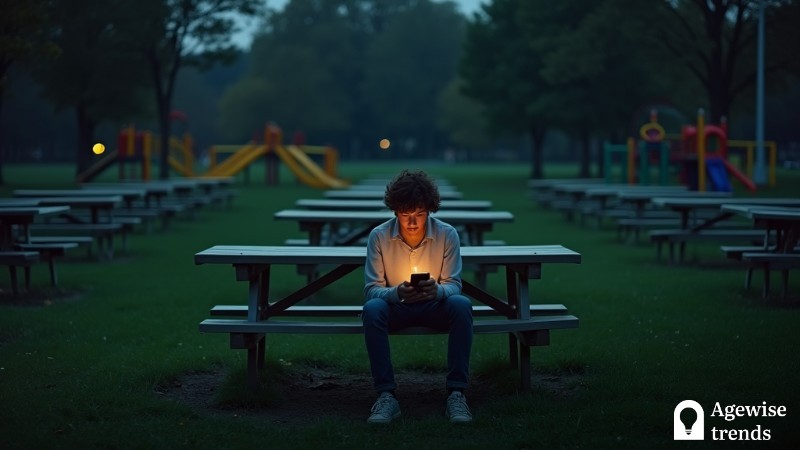Friendship has long been a cornerstone of adolescent development, shaping emotional intelligence, social skills, and personal identity. However, recent trends indicate a marked decline in face-to-face interactions among teenagers, raising concerns about the future of meaningful friendships. Studies reveal that American teens are spending less time socializing in person than ever before, a shift that has profound implications for their mental well-being and social development.
This downward trend signals more than just a temporary change in adolescent behavior—it points to a deeper cultural and technological shift that may permanently alter the way young people form and maintain friendships.
Key Takeaways
A decline in in-person interactions among teens is affecting their ability to form meaningful friendships and maintain robust mental health.
- Technology, like smartphones and social media platforms, has taken the place of traditional hangouts but doesn’t offer the same depth of emotional connection found in real-life interactions.
- Increased screen time is linked to higher rates of loneliness and mental health issues, such as anxiety and depression, among adolescents.
- Tackling this issue calls for a cultural shift toward prioritizing in-person socializing through stronger educational support, community planning, and active parental involvement.
From handshakes to heart emojis
Technology has redefined socialization, replacing traditional hangouts with digital interactions. While smartphones and social media provide instant connectivity, they often fail to replicate the depth and emotional engagement of face-to-face encounters. Many teens now maintain their friendships primarily through platforms like Instagram, Snapchat, and TikTok, which offer curated glimpses into each other’s lives rather than authentic shared experiences.
Psychologist Jean Twenge, a leading researcher on adolescent behavior, has extensively documented the link between rising smartphone usage and increased loneliness. As teens spend more time engaged in digital interactions, their ability to navigate in-person social settings diminishes. Instead of fostering deeper relationships, online interactions often promote surface-level engagement, reducing the opportunity for meaningful connections.
Data supports this shift. In 2015, teenagers spent an average of six hours and 40 minutes per day on screen-based leisure activities. By 2023, this had climbed to seven hours and 22 minutes, showing a clear move away from real-world socialization. While digital platforms can facilitate friendships, they cannot replace the emotional fulfillment of in-person interactions. Instead, the convenience of online communication may discourage adolescents from seeking out real-world connections, leading to an increasing sense of isolation.
Lonely in a crowd
The decline in face-to-face interactions has serious implications for the quality of adolescent friendships. Traditionally, friendships have been strengthened through shared activities—playing sports, attending events, or simply spending time together. These interactions allow young people to develop empathy, conflict resolution skills, and emotional intelligence, all of which are crucial for maintaining long-term relationships.
With fewer opportunities for organic social bonding, friendships today are becoming more performative rather than substantive. The nature of social media encourages aesthetic-driven interactions, where the focus is on appearances rather than emotional depth. This shift may explain why many teens report feeling lonely despite being digitally connected.
U.S. Surgeon General Vivek Murthy has warned about the mental health risks associated with reduced face-to-face interaction, linking it to rising rates of anxiety and depression. Studies show that strong friendships serve as a protective factor against mental health struggles, providing emotional support and a sense of belonging. When these in-person bonds weaken, young people are left more vulnerable to feelings of loneliness and social isolation.
More screens, fewer smiles
While technology is a significant driver of declining adolescent socialization, other societal shifts have also contributed to this phenomenon. Academic and extracurricular pressures have intensified, leaving teenagers with little unstructured free time to socialize. Many students are encouraged to prioritize college preparation and personal achievements over casual social interactions, leading to increasingly isolated lifestyles.
Parental attitudes toward safety have also changed. Many parents today are more protective of their children’s independence, limiting opportunities for unsupervised outings. Concerns about crime, online dangers, and social pressures have led to stricter restrictions, making it more difficult for teens to engage in spontaneous socialization.
Environmental factors also play a role. Suburbanization has reduced access to communal spaces, making spontaneous meetups more difficult. Unlike previous generations, who often gathered at malls, parks, or town centers, today’s teenagers lack easily accessible social environments that encourage in-person interactions. Without these communal spaces, digital alternatives become the default means of communication.
The friendship recession
The long-term effects of declining adolescent socialization extend beyond teenage years. Friendships formed during youth lay the foundation for adult relationships, workplace interactions, and emotional resilience. Without the experience of navigating real-world friendships, young people may struggle to build meaningful relationships later in life.
The decline in friendship is not limited to teenagers—American society as a whole is experiencing a friendship recession. Research reveals that a growing number of adults report having few or no close friends, a sharp departure from previous decades.
The erosion of deep friendships has serious implications. Strong social networks are linked to better mental health outcomes, lower stress levels, and even increased life expectancy. Conversely, isolation can contribute to higher rates of depression, chronic illness, and premature mortality.
Bringing back the hangout
Addressing the decline in adolescent friendships requires a cultural shift that prioritizes real-world social interactions over digital substitutes.
Educational institutions can encourage social interaction by fostering environments where friendships can develop naturally. Schools should emphasize the value of unstructured free time, allowing students to bond outside of strictly academic settings. Likewise, community planners should invest in youth-friendly spaces, ensuring that teens have access to safe and welcoming environments for socialization.
Parents can also take an active role by setting boundaries around screen time, encouraging in-person interactions, and modeling healthy social behaviors. Rather than restricting social outings, families can support gatherings that strengthen friendships and reinforce the importance of human connection.
Friendship thrives in real-world interactions. While digital tools can supplement socialization, they should not replace it. The long-term health of adolescent friendships—and society as a whole—depends on reclaiming the value of face-to-face connection.















